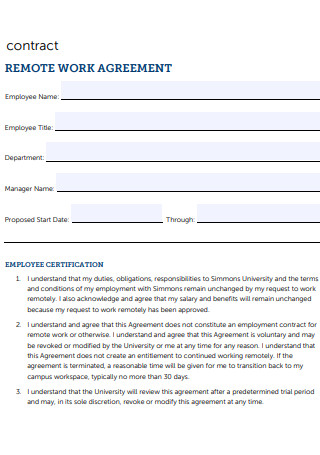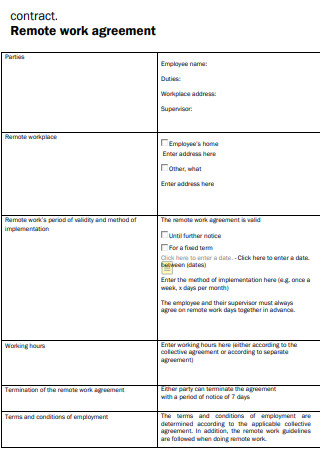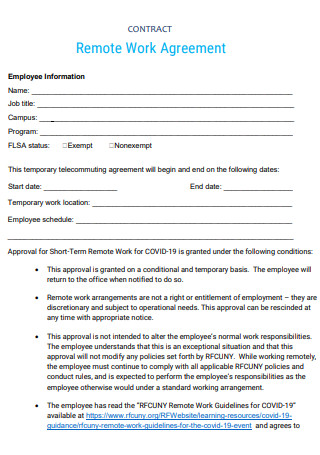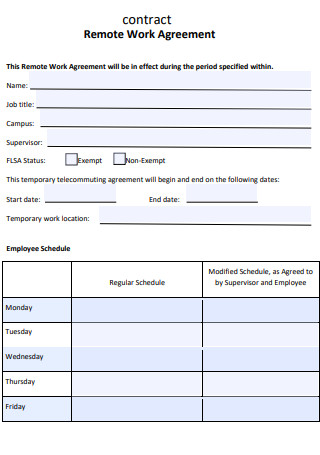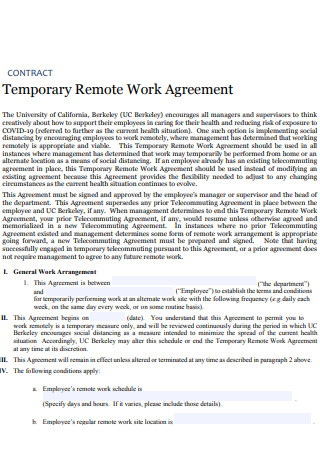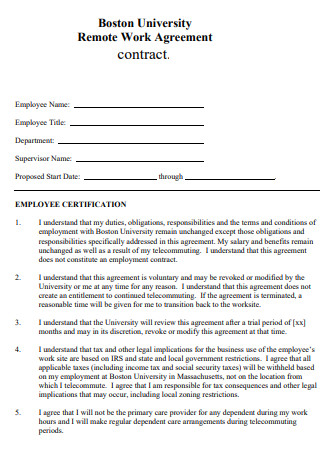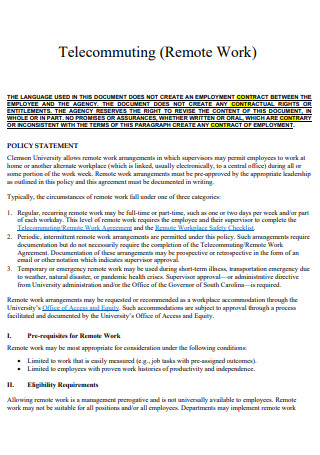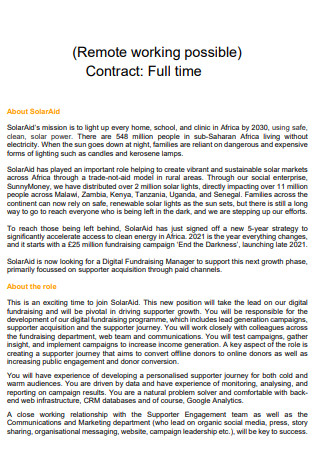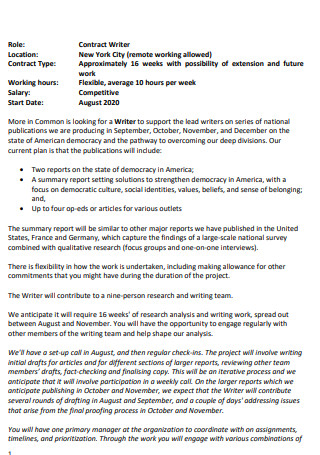9+ SAMPLE Remote Work Contract
FREE Remote Work Contract s to Download
What Is a Remote Work Contract?
A remote work contract is a formal written contract between an employee and an employer. Just like a regular employee contract, it serves as formal documentation that outlines the responsibilities, stipulations, and guidelines with regard to working remotely or off-site.
According to an article published by Forbes, recent studies and surveys have shown that 61% of employees are in favor of shifting to full remote work arrangements. The survey results also showed that 74% of professionals believe remote work will eventually become the standard.
Tips For Remote Workers
Working remotely has been a popular practice long before the COVID-19 pandemic hit. In current times, however, more and more companies were left with no choice but to adopt the work arrangement. For many people, the shift was drastic and required some getting used to. If you fall under the category of remote workers or even hybrid-type workers, these tips might help you better optimize your work from home experience.
Maintain work-life balance. Even though working from home may seem like a dream on the surface, it is not exempt from having its own set of drawbacks as well. As more and more people try to order their days adjusting to the remote work set up, it has become much harder to separate the professional from the personal. Precisely because the work aspect of your life has now entered and overlapped with your home life, it is not far off to say that the lines have been blurred a little. For those working from home, it is important to still set the necessary boundaries and know your limitations when it comes to work. Just as you would do in a traditional work arrangement, you need to find a way to draw the line between your life and your job. Your career is only one important aspect of your life, it does not have to be your identity or encroach on other areas. Stick to a routine. One significant way to maintain a healthy work-life balance is by establishing a routine for work. Even if you are just working from the comfort of your home, you can take steps on forming a routine that works for you. This will help to condition your mind and create a more prominent line separating work functions and home life. It does not have to be a drastic change of routine. Something as simple as waking up at the same time you would if it were an on-site job or having breakfast before clocking in online, structuring your days can give you a some sense of control amid the external uncertainty that you have zero control over. What is important is that you find a routine that’s sustainable and one that works for you. Assign a work space. When working remotely, you need to assign a place in your home where you can work. Dedicating a space for working can be considered one aspect of finding a viable routine. Ideally, the space ought to be conducive to working and free from distractions. Obviously, not all people have the luxury or space to set up a home office. It is in these cases where creativity and resourcefulness can come in handy. No matter how small your area, it can be just a table and chair or a quiet corner in your house, it is important to have that standard working space where you can focus and accomplish your tasks. To minimize distractions, it might help to declutter and maintain tidiness within your work space. As much as possible, choose a room or corner of the house where the people at home are unable to disturb you during office hours. Practice healthy habits. An important part of working from home is maintaining not just a workable routine, but a healthy lifestyle as well. It can be easy to allow complacency to dictate your new work set up. You might be tricked into thinking that working from home can give you more freedom to do what you want and when you want. Although this may prove to be true in some aspects, you need to practice good habits if you want to sustain a healthy work-life balance. Just because a remote set up allows you to work in comfortable pajamas, that does not mean you cannot look presentable or practice good hygiene at home. Habits such as being mindful of the proper posture when at the computer or eating a balanced diet are simple yet powerful ways to stay healthy even if you’re just working at home. Ask for support. When the pandemic hit, the dramatic shift to remote working arrangements caught many people off guard. Even if a lot of people have slowly settled into their work from home routines, there are still many challenges and issues that continue to persist. Whether it is communication problems, isolation, burnout and mental health issues, it has become more important now than ever for people to have firm support in their families, workplaces and their communities. Do not hesitate to seek support when you need it. If work gets overwhelming, open up to your boss or someone you can trust. Getting the right support is key in maintaining balance in your professional and personal life. Even if you love your job, do not neglect to take breaks, sick leaves and vacation leaves when you feel the need to.
Benefits of Remote Work
There can be several benefits to working from home. And although it does not discount the presence of challenges and disadvantages to the unconventional work arrangement, work from home has and is continuing to gain more momentum across all industries. The following examples describe some major benefits of working remotely.
Flexibility. A traditional work set up is structured almost sometimes to a fault. Many corporations and organizations have excessive bureaucratic systems that even their policies have remained rigid and unchanged for decades. However, everyone was forced to rethink their business models and way of doing things when the COVID-19 pandemic hit. The health crisis allowed flexible work arrangements such as remote work or hybrid set ups to thrive. Because employees no longer needed to report on site, remote work arrangements have created a more flexible schedule. People have more control over their time and performance. There is more room to multitask and work at one’s own pace. Lesser Cost. One important advantage of working from home is the savings gained from not having to commute. Depending on individual circumstances, the time and energy spent on the road or en route to the office can be great. Productivity and time wasted in traffic is an issue that many cities and nations face. But with a work from home arrangement, commuting is removed altogether. Not only is more time saved on the road, but transportation costs are cut as well. Employees pay for bus fares, train tickets, and fuel for their cars. Apart from electricity and internet connection bills, much can be saved when you do not even need to step out of the house to work. Lastly, it may not be obvious at first, but constantly dining out can eventually drain your wallet. But public health reasons and various government restrictions have made eating out a challenge. For some people, working from home even helped cut off excessive spending on food and dining out. More time with family. On the surface level, you get to see more of your family and loved ones because you are not spending most of your hours at the office. But this notion can be a tricky one. Yes, constantly being at home may mean you are able to see your family more. However, this does not always result in strengthening family ties. The key in maximizing remote work arrangements for you to spend more time with family is intention. You need to be intentional with your time if you really want to build better relationships with your loved ones. Just because you see them all the time does not mean you are there for them all the time. It is one thing to say you are physically present for your child or spouse, but it is an entirely different thing to be emotionally available and present for them. Being present entails setting boundaries with your work and home life. If it is quality time with your family, stop yourself from checking new emails or replying to non-urgent work calls. More freedom. With flexibility comes a degree of freedom. However, this freedom of working away from a structured office environment must be approached responsibly and wisely. For most people working remotely, they are free to structure their day according to their own needs and preferences. If you are under a work from home agreement, you also get to choose how you want your work environment to be like. One productive way to order your work day is by structuring your routine based on your energy levels. For instance, if you are generally more alert and productive in the morning, get most of your tasks done during the day. But if your ideas come alive at night or during the latter part of the day, you can adjust your schedule accordingly.
How to Create a Remote Work Contract
To create a remote work contract, you need to ensure that both the employer and employee are ready to implement the necessary arrangements. A prior meeting may be set to consult either party or to raise any concerns before the actual drafting of the contract agreement. If you are looking for more convenience, the time-saving sample templates in the collection above are easily editable and printable. When you have gathered all the information you need, simply follow the steps below.
Step 1: Establishment of Parties
In any formal contract, you need to first identify the parties entering into the agreement. In the case of a remote work contract, it is the employee and the employer or company. This introductory section should only be brief and straightforward. The complete names of both employer and employee must be stated clearly. Although optional, you may also include the complete address of either party. If you are unsure of the format of this section of the contract, there are sample templates above that you can use as a helpful reference.
Step 2: Description of Responsibilities
Once you have established the parties involved, the next step is defining the responsibilities and role of the employee. Much like a job description, you need to clearly enumerate and explain what is expected of the employee. Obviously, it is tailored to suit the work from home arrangement. Thus, be specific with the details as much as possible. This section could also expound on the different job requirements and individual deliverables. Even if it is not a traditional work setting, the degree of accountability and ownership should very much still be present and documented.
Step 3: Statement of Terms and Conditions
The next section following the outline of responsibilities is crucial. It is where the terms of contract are formally stated and recorded. There must be ground rules set whenever two parties enter into an agreement. Stipulations essentially cover the scope of work and limitations of what is required from the employee. This could include conditions regarding shifts, schedules, work arrangements and a wide variety of expectations. Will the employer provide the employee with a computer or does the latter have to provide his own? Will internet allowance be taken into consideration on top of regular wages? Enumerating the different terms and conditions can be quite tedious. The sample contracts in the selection above can guide you in constructing and customizing your own set of terms and conditions.
Step 4: Agreement of Parties
Finally, the last section of your remote work contract is the formal declaration between the two parties. The formal acceptance and agreement of terms should be stated clearly and definitively at the end of the contract. As you draft the agreement, make sure to leave ample space for both employer and employee to affix the date and their signatures. This formal act of declaration of agreement is standard in most contract signings. It officially cements the consent and approval of terms that were previously stated.
FAQs
What should be in a remote work policy?
A remote work policy should set the right expectations for employees to follow. Policies must be reasonable, fair, detailed and implementable. For example, a policy ought to cover employee work schedules and the standard mode of communication while working remotely.
Is remote work illegal?
Remote work is legal and adopted by a lot of companies. Any form of remote work or hybrid work arrangements is always subject to the agreed terms of both the employer and employee.
What is another term for working remotely?
Remote work is also commonly referred to as work from home (WFH), telecommuting or telework, and distance working.
Remote work seems poised to become the new norm in a post-pandemic world. There is still much to be explored and improved when it comes to non-traditional work arrangements. In the meantime, browse and download any free sample template above to get started on your own remote work contract!
